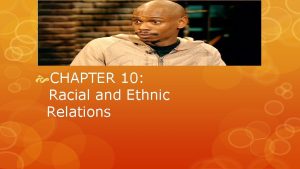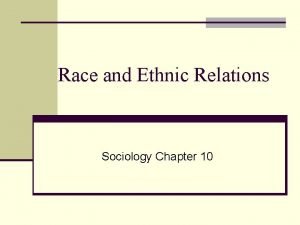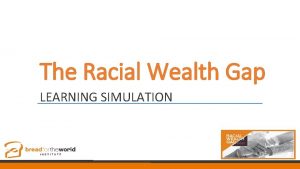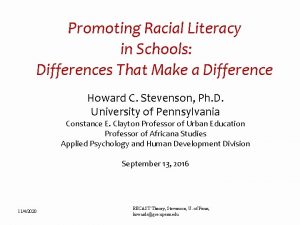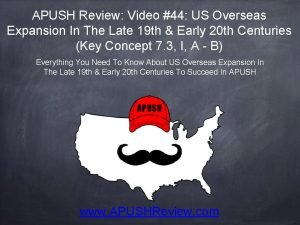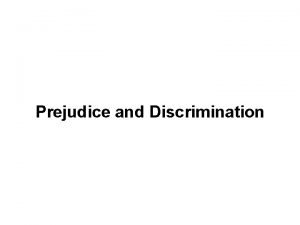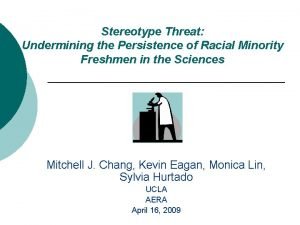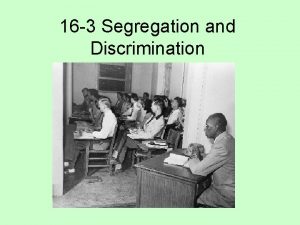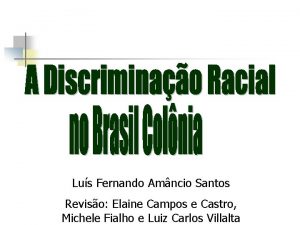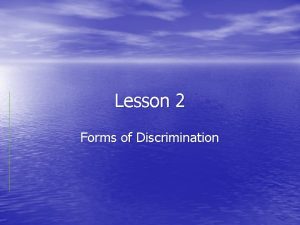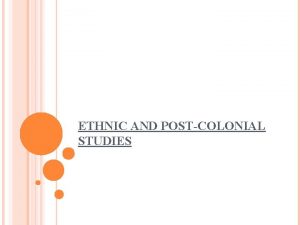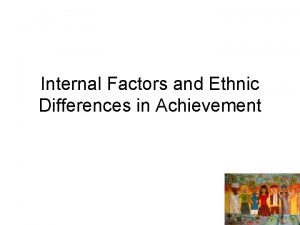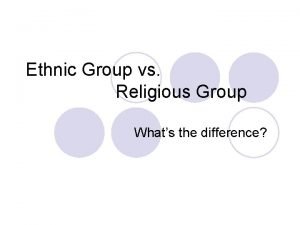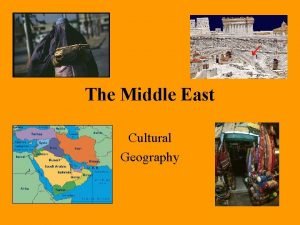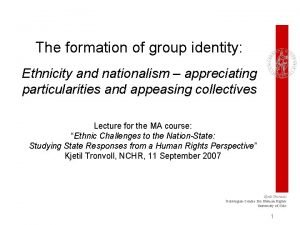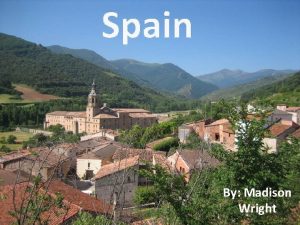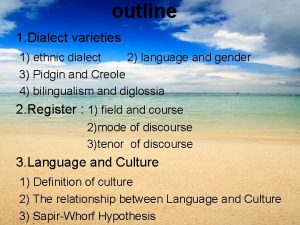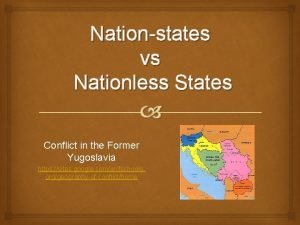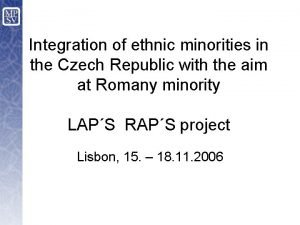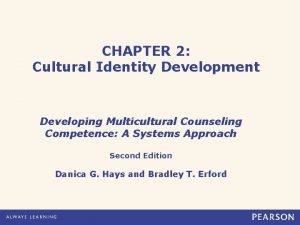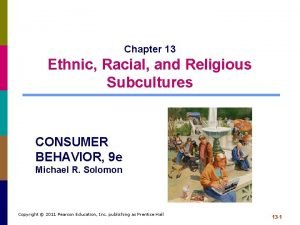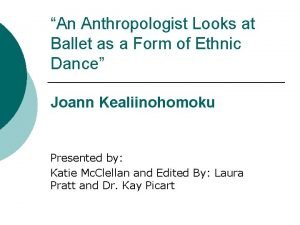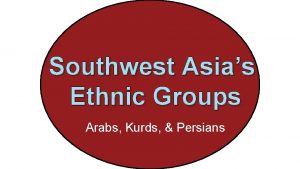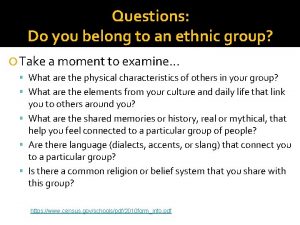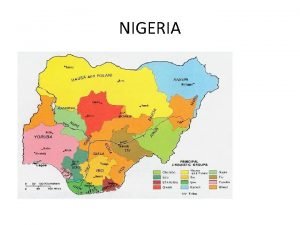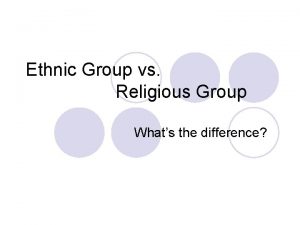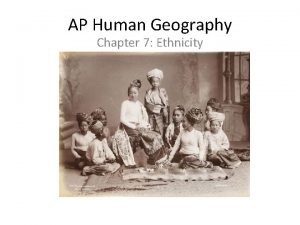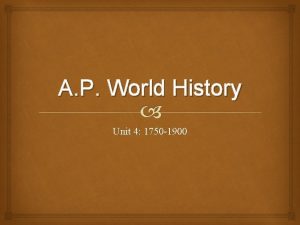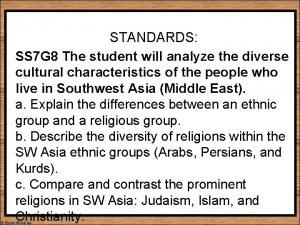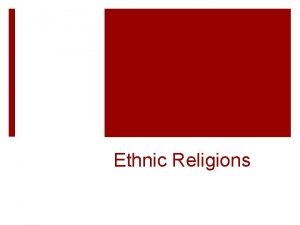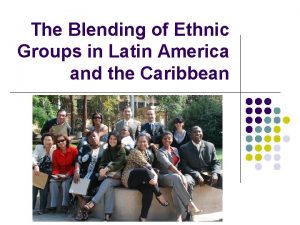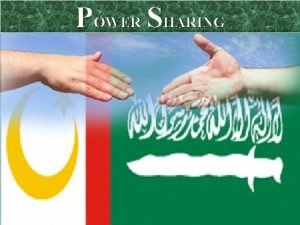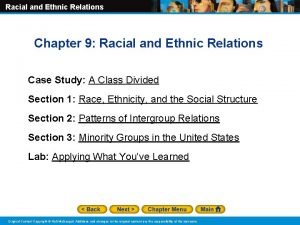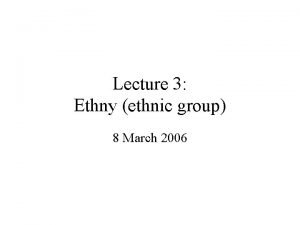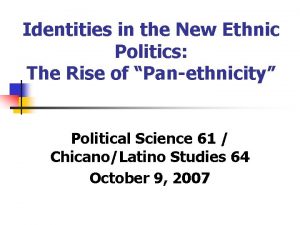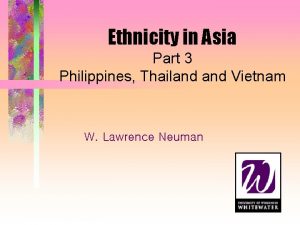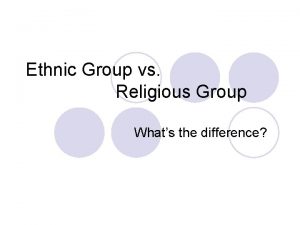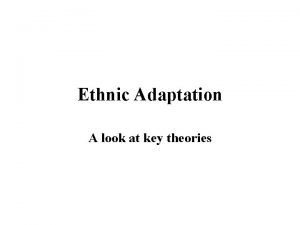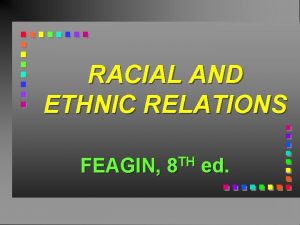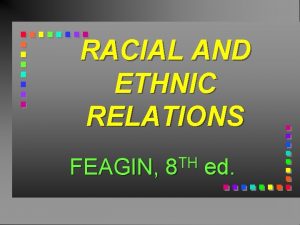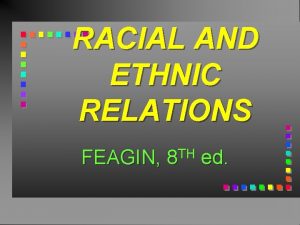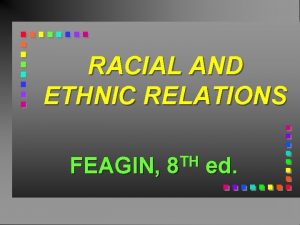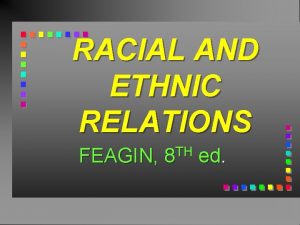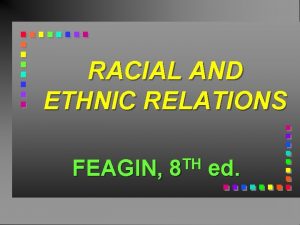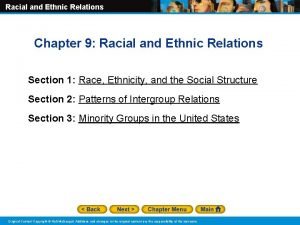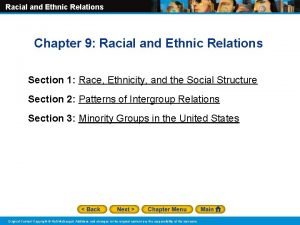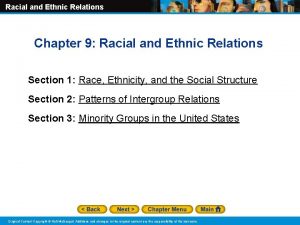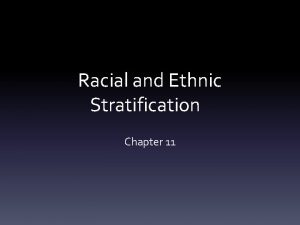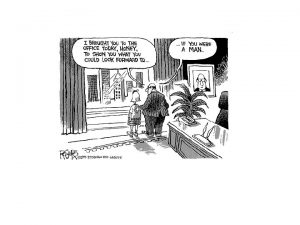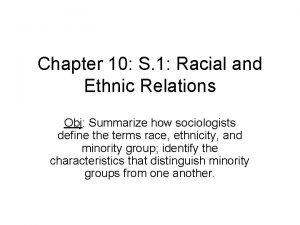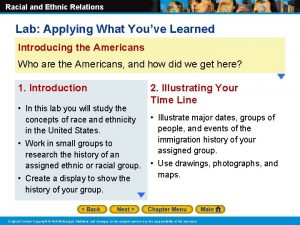RACIAL AND ETHNIC RELATIONS FEAGIN TH 8 ed


































































- Slides: 66

RACIAL AND ETHNIC RELATIONS FEAGIN, TH 8 ed.

A NATION OF IMMIGRANTS An Overview of the Economic and Political Conditions of Selected Racial and Ethnic Groups PART II

IMMIGRATION, THE ECONOMY, AND GOVERNMENT • Stages of North American economic development • • Mercantilism and early commercial capitalism coupled to a plantation/slave economy Competitive industrial capitalism Advanced multinational capitalism Economic institutions and government actions shaped the character of immigration

Continued on next slide

Continued on next slide


COMMERCIAL CAPITALISM AND THE SLAVE SOCIETY: 1600 s-1800 s • COLONIAL SOCIETY AND SLAVE LABOR • • • Colonial society was tied closely to England expansionist policies of English political and economic elites Objective of English colonization was to secure raw materials and markets for English goods Colonies became home to many displaced from land in Europe

• • In late 18 th century, emergence of cotton and sugar as international commodities created stronger demand for workers on slave plantations African Americans increased • • 59, 000 in 1714 to 3. 9 million in 1860 Forced labor generated wealth for many whites • • Built up profits for further investment and bank deposits Used or borrowed by white merchants, shippers, and industrialists of North and South

• Civil War: The Southern Plantation South most prosperous region in the country and white southerners owned • • • Much of the productive land Agricultural produce for export Processing mills and other valuable equipment Millions of enslaved African laborers Most Presidents, including George Washington and Abraham Lincoln, were slaveholders or sympathetic to slavery Civil War was a struggle for economic and political power between northern industrialists and small farmers on the one hand the southern Plantation oligarchy, on the other

• • • Immigrant Laborers in the North Immigrant labor often became the labor for industrial enterprises Pull and push factors motivated the immigration of millions to opportunities Arrival of large numbers of white immigrants laid the foundations for new patterns of racial conflict • • Free black laborers were used as strikebreakers against white strikers which increased hostility toward blacks In the 1840 s black workers were being forcibly displaced by white immigrants

Western and Global Expansion • • U. S. governmental decrees and military protection in the westward expansion brought Native Americans and Mexicans into the orbit of exploitation “White man’s civilizing responsibility” • • Guided and justified white expansionists in taking Native American and Mexican lands in the West First Mexican citizens did not migrate but were brought into the U. S. by force • • Mexican –American War 1840 s Monroe Doctrine • U. S. replaced European colonial power as the dominant colonial power

INDUSTRIAL CAPITALISM: 1860 s-1910 s • Industrial Capitalism and Government Expansion Overseas • Competitive Capitalism • • U. S. industrialists expanded corporate investments and activities in numerous countries overseas • • An economy dominated by small and medium-sized for profit businesses Backed by a growing military power U. S. military and economic power pressured Asian countries to submit to U. S. influence

African Americans: Exclusion from Western Lands • Second half of 19 th century was a period of major governmental and bureaucratic growth in the U. S. • • Government had major influence on racial and ethnic relations Homestead Act (1860 s) -- Abraham Lincoln • • Wealth-building program for white immigrant families seeking land U. S. Land Office ruled most black Americans were ineligible for land grants

• • Black families did not have the opportunity that many white families had to build up landed wealth passed down to millions of their descendants Late 1800 s; early 1900 s • • • Southern black laborers were possible source of labor for northern industries Southern white oligarchy using Klan-type terror tactics made certain that newly-freed blacks remained in the South as low-wage laborers Little land distribution to black men and women • Did not receive the “forty acres and a mule” promised by the government

Southern and Eastern European Immigrants • Northern industrialists turned to Europe • • Unable to use or preferring not to use Southern black labor Between 1881 and 1920, 20. 7 million immigrant arrived in U. S. from southern and eastern Europe • • Labor shortages and increasing wages for native-born white workers encouraged immigrant labor Six of every ten workers were foreign born • New workers displaced native-born white workers leading to antiimmigrant hostility • Nativism

European Immigrants and Black Americans • Irving Kristol • “The Negro Today is Like the Immigrant of Yesterday” • • • Experience of black Americans moving to industrial cities was not different than that of white immigrant groups African Americans should eventually move up economically and socially as those immigrants Argument overlooks important differences between the experiences of white and black immigrants to industrial cities

• Reasons for group mobility among European immigrants • • • 1. Most arrived at a time when urban jobs were generally available 2. Many had some technical or other skills or a little capital 3. Most faced far less severe employment and housing discrimination than black workers in cities 4. Most found housing, however inadequate, near their workplaces 5. In key cities, the political system was changing from Anglo-Protestant business dominance to power shared between business elites and politics oriented to white immigrant voters

• Situation for African Americans moving from the South after 1910 was different • • • Had little access to good government jobs Regularly displaced by white immigrant groups who forced them out Stanley Lieberson • • Black migrants were the victims of more severe discrimination over a longer period of time than white immigrants Economic competition between whites and growing group of black workers in North led to hostility and institutionalized discrimination by whites

ADVANCED INDUSTRIAL MULTINATIONAL CAPITALISM: 1910 s-2000 s • MEXICAN IMMIGRANTS • Mexican labor filled the need for industrialized labor accompanying WWI • • Mexican labor and family migrations increased significantly in the 1920 s “America has used African, Asian, Mexican, and to a lesser degree, Indian workers for the cheapest labor, concentrating people of color in the most unskilled jobs, the least advanced sectors of economy, and the most industrially backward regions of the nation”

Large Corporations and the U. S. Business Cycle • Multinational Capitalism • • The economic system that is dominated by large-scale, forprofit corporations that operate in many different countries, thereby creating an international market system By 1920 s, large numbers of Americans, including immigrants, worked in auto and steel industries • • • Aggressive competition led to overproduction Led to cutbacks in employment which affected blacks Great Depression “New Deal” program of 1930 s discriminated in their social welfare programs

The Postwar Era: The U. S. and the World • • For three decades after WWII, U. S. government, military, and multinational corporations dominated the world economy Capital flight and job exports resulted in economically abandoned central cities • • Government facilitated the outward expansion of large firms and of middle-class (disproportionately white) workers living outside central cities Workers, people of color, moved to the central cities • Thus older cities have seen an increase in the political influence of Americans of color in recent years

Government Involvement Overseas and Asian Immigration • Until mid-1960 s, restrictive U. S. immigration legislation prevented Asian immigration • • • U. S. support for South Korea led to migration to U. S. Chinese, Filipino, and Vietnamese migration result of U. S. government and corporations overseas Increasing corporate and political ties between U. S. and China encouraged migration of Chinese seeking better economic opportunities and political freedom

Latin American Immigration • Caribbean immigrants from the 1960 s • • Cubans and Haitians Cuban immigrants considered political refugees • • Received millions of dollars in federal subsidies Haitians, also political refugees • • Not welcomed by U. S. and many forced to return Haiti viewed as political ally of U. S.

• Mexican immigrants are significant proportion of undocumented immigrants • • • Jobs Poor economic conditions in Mexico U. S. Corporations play a role in Mexican out-migration • Takeover of land from small Mexican farmers • • Migrate to Mexican cities and U. S. Nativistic attacks of Mexican immigrants ignore U. S. -generated push factors that drive poor Mexicans to the U. S.

Middle Eastern Immigration • • Arab immigration occurred in two segments: 1880 -1945 and 1945 -present Working and middle-class seeking economic opportunity 1924 Immigration Act sharply reduced Middle East immigration Began to increase after Act abolished in the 1960 s • • Many educated professionals or business people Disproportionately self-employed in their own businesses

Immigration Restrictions • • Europeans more than half coming to the U. S. in the 1960 s Asian, Latino, and Middle Eastern immigrants viewed as a “problem” • • Congress passed legislation restricting non. European immigration American workers and politicians concerned that U. S. cannot absorb new immigrants • Ratio of immigrants to native-born population higher in early 20 th century than now

• • Percentage of foreign-born in U. S. population smaller than other countries including Europe Implicit in European American discussion of new immigrants: • Concern that most are from Asia and Latin America • • They are not white and not European Growing population of Americans of color • Majority population in many areas of U. S.

ENGLISH AMERICANS AND THE ANGLOPROTESTANT CULTURE CHAPTER 3

• Ethnicity involves cultural or nationality characteristics distinguished by: • • • Lines of descent are important channels • • Group itself Important out-groups Passes ethnic characteristics to later generations English-Americans • • Americans of English ancestry 3 rd largest white ethnic group in America after German and Irish Americans

• • Terms Anglo-Saxon and white-Anglo. Saxon Protestant are inaccurate in describing “English Americans” Anglo-Saxon • • Originally referred to Germanic tribes, the Angles and the Saxons, who came to the area now called England in the 5 th and 6 th centuries A. D. Later applied to the inhabitants of England to those English who came to North America

• Anglo-Protestants • • More accurate term for those often referred as Anglo-Saxons Also appropriate • • • White Anglo-Saxon Protestant Americans American culture, speech, and laws are Anglo-Saxon in origin Americans of British descent often expressed a sense of their superiority and prominence in the new nation

THE ENGLISH MIGRATIONS Some Basic Data • • • English were the first Europeans to colonize in large numbers Migration to North American colonies were heavily English until 1700 English migration to colonies and then later to U. S. was one of the largest population flows of the period

The First Colonial Settlements • 17 th century English migration viewed as colonization migration • • Involves the subordination of indigenous societies Reasons for British colonization • • • Need for trading posts, raw materials, and new markets for English goods Protestant missionary objectives, search for passage to Asia, need to stop Spanish and French expansion Need for a place for England’s surplus population

• European colonists viewed Native Americans as “savages” • • • Should be driven off the valuable land Established large settlements using royal companies Jamestown and Plymouth settlements nearly expired • • Disease and starvation Plymouth colony assisted by supportive Indians

• Four distinctive English-speaking groups • • • Puritans Virginia royalists Quakers Appalachian backcountry Each group had a distinctive culture Distinctive cultures fused over time to create dominant Anglo-Protestant culture


Later Migration • • Century following 1820 saw greatest Atlantic migration in history As English workers were displaced by machines or later immigrant groups • • They or their descendants moved into clerical and professional jobs English immigrants shared ethnocentric or racist views of English colonists

Other Protestant Immigrants • Anglo-Saxon and Anglo-Protestant • • • Included English, Scots, Welsh, Scandinavians, and Germans Scots closest to dominant English group in terms of political and economical power German immigrants made up the largest non-British group during 18 th century • • • Largest proportion was Protestant Farmers, merchants, and industrial workers Cultural assimilation, mobility in economic and political spheres came in a few generations

The Invention of the “White Race” • 18 th and 19 th centuries saw the emergence of the “white race” • • Deliberately socially-constructed social group English colonists and their descendants saw themselves differently from indigenous Americans and black Americans • • Stereotyped as uncivilized, idolaters, and savages Growing importance of southern plantations increased demand for Native American land African slaves

• • White Anglo-Protestant elites circulated idea of an advantaged “white race” and inferior Indian and African “races” U. S. founders played a central role in this racial framing of society central to the thinking of most white Americans • • Thomas Jefferson, James Madison, and George Washington Thomas Jefferson • African Americans greatly inferior to white Americans • Skin color, physical form, reason, familial love, forethought, and ability to feel pain and grief

• • Many 19 th-century European immigrants not initially defined as white gradually came to construct themselves as white as they moved up economically and politically President Andrew Jackson (1829 -1837) • • Development of racist frame and whitesupremacist ideology accelerated Racial privileges generally included: • • • Right to substantial personal liberty Right to travel and immigrate Right to vote (men only initially)

NATIVIST REACTIONS TO LATER EUROPEAN IMMIGRANTS • Nativism • • • An anti-immigrant ideology that advocates the protection of the native-born inhabitants of a country from immigrants who are seen as threatening or dangerous Focused on the religious and moral undesirability of new immigrants Ambivalence of established colonists • On one hand, provided needed labor; on the other, sometimes seen as a threat

More Fear of Immigrants • Anti-foreign sentiment took legal form in late 1700 s • • Federalist party concerned about political radicalism Strategies designed to limit political power of immigrants • • • 1798 Alien Act Citizenship eligibility raised from 2 to 5 years in 1795 and 14 years in 1798 Attempts made to set exorbitant fee for naturalization

• • Anti-Catholic sentiment fueled nativist agitation Nativism coupled with racist ideologies in the 19 th century • • U. S. socioeconomic development celebrated as perfect example of Anglo-Saxon race accomplishment Social Darwinism • A perspective that extended Charles Darwin’s evolutionary thinking into the social realm and thus would produce a culture that embraces the “survival of the fittest”

• • Nativism and Racism since 1890 Anti-immigration at turn of the 20 th century focused on Asia and southern and eastern Europe Immigration League • • Instituted literacy tests which passed Congress Associated with eugenics movement • • Allowing “unfit” southern and eastern European immigrants (Catholic and Jewish) to enter would destroy the superior race Madison Grant • Prominent American who contributed to development of racist nativism

• Nativist Ku Klux Klan (1920 s and 1930 s) • • • Recent nativism • • Subordination of African, Catholic, and Jewish Americans Provided social outlet for those wishing to preserve the Anglo-Saxon race Taken the form of ethnic stereotyping and harassment of Americans not of northern European ancestry Websites attack non-European immigrant groups • Threat to American jobs and Anglo-Protestant culture

THE DOMINANT CULTURE AND MAJOR U. S. INSTITUTIONS • • Most analysts assume that the dominant culture and institutions of the U. S. are substantially Anglo-Protestant in character Dominant U. S. political, legal, and economic institutions have generally been based on English models

Language • • U. S. has no official language de facto dominance of English language signals the impact of early English colonists and their descendants Principal U. S. language is a blend of Native American and early immigrant languages with the incorporation of European and U. S. sources Assimilation pressures first took the form of language pressure

• • Today, millions of Americans live in homes that speak a language other than English National English Campaign goals • • • 1. Replace ethnic group identification with an American identity based on individual citizenship 2. Establish English as the official language of government, schools, and elections Such goals suggest fear of pluralism of racial and ethnic groups and cultures

• Civil rights leaders pointed out discriminatory nature of actions advocated by pro-English groups • • Prohibition of Spanish usage by government agencies Elimination of bilingual programs in public schools Elimination of bilingual ballots in states with numerous Latino voters Nativist campaigns that promote use of the English language underscore its traditional dominance

• Irony of aggressive English-only movement • • Most immigrants being attacked recognize the political, social, and economic discourse Strive hard to learn the language 3/4 ths of Latino immigrants speak English every day Lack of knowledge of languages other than English cripples many Americans who conduct business abroad or deal politically with people from other countries

Religion and Basic Values • • English religious influence has been of great importance since colonial days For first 200 years, English religious denominations dominated North America Catholic, Jewish, and non-British Protestant faiths shaped by “American way of life” Anglo-Protestant culture’s effects on non. Protestant religions of later immigrants have been uneven and incomplete

• Protestant Work Ethic • A view of life that promotes hard work and self-discipline • • At the center of the U. S. value system Linked to the pursuit of personal profit and forever renewed profit • • • Means of continuous, rational, capitalistic enterprise English religious traditions influenced music and arts in the first two centuries Over next few centuries, English influence on U. S. popular music receded before pervasive African American music • Music is one major area of U. S. culture where English influence has mostly disappeared

Education • English and other British Americans took advantage of limited educational opportunities in the colonial period • • • Affluent parents sent children to private schools established before 1800 Public school movement began in earnest in 1900 s John Dewey • • Education should bring greater mobility opportunities for poor immigrants Social control function and Anglo-American influence on public schools still evident today

Political and Legal Institutions • Political and legal institutions shaped by English heritage • Mayflower Compact (1620) • • • Political framework that theoretically provided for equality under the law New England Puritan institutions often provided model for later U. S. political and legal developments North American colonies developed political institutions characteristic of 16 th and 17 th century England • • Unity of government and society Subordination of government to law Balance of power between legislature and executive Heavy reliance on local governments

• American government separated into three national branches • • Executive, judicial, and legislative Position of president is unusual • U. S. does not distinguish between head of government and chief of state • • • U. S. is new society, but is an “old” political state Representative government is an example of English influence U. S. legal framework reflects English influence • English common law asserted to be “the measure of rights of Americans”

Officeholding • English Americans have had major impact on operation of U. S. politics • • English Americans have filled disproportionate number of major offices Declaration of Independence signed by 56 European American men • • Constitution framed around their concerns • • 38 English, 9 Scottish, 3 Irish, 5 Welsh, 1 Swedish For democratic institutions and protection of their own property and wealth U. S. presidents from Washington to Bush • 2/3 rds have English ancestry and all had northern European backgrounds

Economic Institutions • English heritage substantially reflected • • • Mercantile capitalism • • Norms and values of capitalistic institutions Dominance of English Americans State directed capitalism linked to English nationalism Industrial capitalism developed in the U. S. after 1830 • Investment and many technologies used for U. S. industrial development came from England

Direct Participation in the Economy • English and other British Americans have regularly influenced operation of U. S. economy • • Direct control of business and political positions U. S. industrialization in 19 th century fueled by English and Dutch capital • “Robber barons” • John D, Rockefeller, Leland Stanford, J. P. Morgan

Contemporary Elites • Thomas Dye – 1970 study of U. S. decision makers • “Great power in America is concentrated in a tiny handful of men. A few thousand individuals out of 200 million Americans decide about war and peace, wages and prices, consumption and investment, employment and production, law and justice, taxes and benefits, education and learning, health and welfare, advertising and communication, life and leisure. ”

• Recent decades • • Influential Americans now a much more representative group View that elites today represent a break from their predecessors is inaccurate • • Must distinguish social and economic realities from rags-to-riches myths Catholic and Jewish Americans not proportionately represented at top of economic pyramid Few non-Europeans can be found at or near the very top of largest U. S. corporations Continuing pattern of disproportionately white, northern European Protestant dominance at top levels

English Americans as a Group: Economic and Other Demographic Data

ENGLISH-AMERICANS TODAY • Group whose culture and institutions usually the standard against which assimilation is measured • • • Rarely researched Residential dispersal characteristic of English Americans and northern Europeans 40 to 50% said ethnic identity had no importance to them • May view English or British identity as synonymous with being American

• • Regional variations in English American culture are still evident David Fischer analyzed relationship between regional diversity today and colonial cultures of the four English immigrant groups • Homicide rates • • • Low in areas of New England with Puritan tradition of order and nonviolence High in southern areas settled by immigrants from Great Britain’s northern boundaries Education and gender equality • High rates of high school and college graduation today are those whose colonial cultures valued education

• • States that failed to ratify Woman’s Suffrage Amendment and Civil Rights Amendment were those whose colonial culture women had low status Distinctive region is the South • • Settled by English from borderlands Important part of southern white population descended from Irish immigrants Large proportions of French, Spanish, or German in South Submerged in ethnically diverse white population that emphasize whiteness above all else

• • • Theoretical frameworks of assimilation analysis generally take English and/or British Americans, their culture and institutions as starting point for analysis of assimilation in U. S. Power-conflict theorists emphasize ways in which English colonization process initiated racial and ethnic stratification in the U. S. Subordination or extermination of Native Americans is example of migrant superordination and enslaved Africans was example of indigenous superordination
 Chapter 10 racial and ethnic relations review worksheet
Chapter 10 racial and ethnic relations review worksheet Chapter 10 racial and ethnic relations
Chapter 10 racial and ethnic relations Chapter 10 racial and ethnic relations review worksheet
Chapter 10 racial and ethnic relations review worksheet Feagin mill middle school
Feagin mill middle school Black studies and the racial mountain
Black studies and the racial mountain Employee relations in public relations
Employee relations in public relations Racial etiquette targets
Racial etiquette targets Racial wealth gap simulation
Racial wealth gap simulation Promoting racial literacy in schools
Promoting racial literacy in schools Anti imperialist league apush
Anti imperialist league apush Racial prejudice
Racial prejudice Don tiborcio
Don tiborcio Racial insults
Racial insults Chapter 16 section 3 segregation and discrimination
Chapter 16 section 3 segregation and discrimination Cartel ley organica contra la discriminacion racial
Cartel ley organica contra la discriminacion racial Democracia racial
Democracia racial Lesson 2 discrimination
Lesson 2 discrimination Ethnicity in postcolonial literature
Ethnicity in postcolonial literature Ethnocentric curriculum
Ethnocentric curriculum Whats ethnic group
Whats ethnic group How are ethnic groups and religious groups related
How are ethnic groups and religious groups related Is buddhism monotheistic or polytheistic
Is buddhism monotheistic or polytheistic Cultural geography of the middle east
Cultural geography of the middle east Ethnic boundary marker
Ethnic boundary marker Nadia kajouj
Nadia kajouj What is the absolute location of spain
What is the absolute location of spain Denomination ap human geography
Denomination ap human geography Example of universalizing religion
Example of universalizing religion Ethnic formation
Ethnic formation Nigga
Nigga Nation vs state
Nation vs state Ethnic groups in the middle east
Ethnic groups in the middle east Ethnic groups cloze notes 1 answer key
Ethnic groups cloze notes 1 answer key Ethnic groups in czech republic
Ethnic groups in czech republic The world's largest ethnic religion is
The world's largest ethnic religion is Cultural identity development models
Cultural identity development models Ethnic subcultures
Ethnic subcultures An anthropologist looks at ballet summary
An anthropologist looks at ballet summary Write 5 ethnic groups you know in panama en español
Write 5 ethnic groups you know in panama en español Potomac section wv
Potomac section wv Southwest asia ethnic groups
Southwest asia ethnic groups Which ethnic group do you belong to
Which ethnic group do you belong to Lute hole
Lute hole 250 ethnic groups in nigeria
250 ethnic groups in nigeria The divine masculine
The divine masculine Acculturation
Acculturation Whats ethnic group
Whats ethnic group Ethnic groups
Ethnic groups Ethnic hash answers
Ethnic hash answers Shatterbelt definition ap human geography
Shatterbelt definition ap human geography An anthropologist looks at ballet as a form of ethnic dance
An anthropologist looks at ballet as a form of ethnic dance Manifest destiny era
Manifest destiny era Whats ethnic group
Whats ethnic group Hajangs
Hajangs Ethnic groups cloze notes 1
Ethnic groups cloze notes 1 Ethnic groups coat of arms
Ethnic groups coat of arms What is the world's largest ethnic religion
What is the world's largest ethnic religion Ethnic blending
Ethnic blending Power sharing among different social groups in india
Power sharing among different social groups in india Baltic finnic ethnic group
Baltic finnic ethnic group What is an ethnic dance
What is an ethnic dance Ethnic
Ethnic Fact file on ethnic groups in bangladesh
Fact file on ethnic groups in bangladesh Panethnic
Panethnic Vietnam ethnic map
Vietnam ethnic map Whats an ethnic religion
Whats an ethnic religion Ethnic stratification
Ethnic stratification

